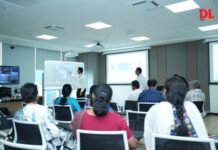How can one lead a whole school to positive changes when ICT utilization is a major challenge at both classroom and individual levels? When ICT has brought changes to learning and teaching experiences, each school is the battle field for those changes. In an effort to examine and demonstrate how schools could adjust to change, The Ministry of education, Thailand launched a pilot project in schools that proved that principals of schools essentially become more important in bringing changes to their schools. The emerged “LEARN” Model encompasses learning, evaluating & monitoring, assisting, rewarding, and nurturing functions. Despite the promising roles and responsibilities to challenge changes, neither is the model a panacea for any similar program nor an absolute solution for any school in the kingdom. Dr.Rangsun Wiboonuppatum of the Bureau of ICT of the office of the permanent secretary, the royal Thai Ministry of Education, discusses the Ministry’s initiative and explains the LEARN Model.
Globalization is an interconnected and changed phenomenon in political, cultural, social, and economical spheres. Together with changes in those spheres, information and communication technology is emerged (Mittman, 2001). Although the emerging is not new, it affects social members greatly. In addition, the emergence of information and communication technology (ICT) use in education has already challenged many countries to increase accessibility in both quality and quantity to their citizens. Given the globalization together with rapid hange in technology, ICT is coming to be at the core of preparing students for successful participation in the knowledge economy and learning society (Kozma, 2001). To prepare students for the future, a society need to consider curriculum, instruction, technology, and management. Moreover, professional development is an important strategy focusing on how to equip teachers and principals with proper skills and attitude on ICT in education. During the past three decades, there has been considerable progress in integrating ICT into classroom. Computers have evolved from complex machines. This required sophisticated skills to operate them to simple tools that even young children can operate at ease. Over this same period, access to ICT has become more widespread. As educational software becomes available, and teachers and students have gained confidence and skills in using the technologies, ICT has moved from the computer lab to the classroom, and is now appearing in more and more homes (UNESCO, 2004). In order to improve educational administration and management in educational institutions, the Thai government has initiated an innovative framework in a project called, “Mini-Ministry of Education.” Inside the framework, the “Educational Innovation Committee” was established to supervise the project which will be implemented during the fiscal years 2003-2006 (MOE, 2004). The project, in which students will be regarded as individuals with different capabilities and aptitudes, included five types of model schools in the school year 2003 as follows: the state-supervised schools, bilingual schools, schools for gifted students, Buddhismoriented schools, and ICT Model Schools. This report will focus on ICT Model schools which are schools that apply ICT in developing the body of knowledge as well as integrating ICT into the teaching and learning process and the learners’ development activities. Originally, there were 12 schools and five universities participating in the project. The participating schools have been supervised by one of the following universities: Chulalongkorn University, Kasertsart University, Silapakorn University (Sanamchandra Palace Campus), King Mongkut’s University Technology Thonburi (KMUTT), and King Mongkut’s Insitute of Technology North Bangkok (KMITNB). Two years later, two schools and two universities; Thamasart University and Meafahluang University, joined the project after the establishment of the Bureau of Educational Innovation How has the project been implemented? The ICT Model School project aims toexplore alternative approaches on how to integrate ICT into school and classroom activities. It was to improve teachers’ professional development by asking collaboration from university professors (Wiboonuppatum, 2003). The university professors mainly help school staffs in empowering school teachers and principals to gain knowledge and skills in ICI application and integration in their nstruction as well as school management. The project has five major strategies: school and university collaboration, stakeholder participation, professional development, lesson-learned exchange, and collaborative learning among participating schools. First of all, the project brings university professors and schools teachers including administrators together to promote more effective use of information and communication technology (ICT). The principle also lies on asking more stakeholder participation. It is important for schools to take initiatives in ICT utilization. However, due to the limited funding, schools shall seek any financial support from various stakeholders (parent and community members). During the project implementing, all participating schools regularly meets at each school to take turn hosting the meeting event. The meeting purpose was also to visit and share idea and to exchange lessonlearned from each school to its peers. Within the collaborative framework, the professor universities also supported professional development to school teachers and administrators. The professional development mostly aims to enhance school teachers and administrators’ understanding on ICT utilization. Having ICT as hardware and software in schools does not guarantee the school staffs could integrate ICT for student’s improvement. Therefore, there were number of professional development series initiated by each participating university including Intel teach to the future, IT youth camp, Animation camp, Thik.com workshops, etc to ensure the students can benefit from the program. Moreover, the participating schools are built in the supporting network which school staffs share their expertise among themselves and also encourage each other during the project implementing period. The project has been initiated by the office of permanent secretary (the bureau of information and communication technology) during 2003 and was adopted by the office of basic education commission (the bureau of educational innovation) the following year. It was an interesting pilot project because each university takes its initiative in introducing ICT pedagogy integrated approached in a very limited resource. It was not a full funding project because the MOE needs also to see how the school will cope up with budget constraints and how university could help their partner schools to work in challenge situation both budget aspect and emerging of ICT in education context.
What are questions and data collection methods?
This is a report paper on a pilot project from the Ministry of Education. Although the project primarily aims on collaborative efforts among schools and universities, the report aims to answer one major question: what are school principals’ roles and responsibilities in the project that we can learn from the practical perspectives of school principals. In addition, the report should be able to shed light on how we as educators can prepare ourselves to the digital age in emerging new environment in schools. Moreover, there are few more questions: such as “How can one lead a whole school to positive changes when ICI utilization is a major challenge at both classroom and individual levels?”, “What recommendations from those administrators on deploying ICT integrated approaches in their school improvement plans and school development?” etc. I spent a number of hours talking to participating school principals about their vision and strategies including their participation in launching the project. This is an in-depth attempt to shed light on various related aspects. The method has to rely on the understandings, opinions, and perspective of various stakeholders (Wiboonppatum, 2002). In addition to those long hours meeting were conducted, I also conducted a focus group on how the principals would continue ICT utilization in their school contexts. Ten principals and four school ICT coordinators participated in the focus group. Moreover, ten school ICT coordinators participated in semistructure interviewed to reflect on how their schools’ principal support and manage ICT in school movement in their context. I gather all information and use content analysis technique by sorting out pieces of information in different themes. I then check the divergence and convergence of each theme under a major question posed in this section. Although this is a report, the data collection method has to be flexible enough to allow the process to adequately comprehend principal perspectives, to encourage informants to express their opinions effectively, nd have sensitivity to and curiosityabout what is perceived by various participants (Vidich & Lyman, 1998).
What are school principals’ roles and responsibilities?
The project has launched since 2002 with agreement among volunteering schools and universities. It was interesting that the principals must voluntarily agree to participate in the project. This approach also goes in the university side. Therefore, a crucial aspect of the project started from the participating schools and universities agreement on how to work in concert to make use of ICT in each school context. The principals were challenged by their own efforts. University professors were also challenged by their know how to integrate, help and foster ICT utilization in their responsible schools. The project has been consecutively conducted for three years. The major challenge is still on leaders. Some schools have done a wonderful implementation of ICT utilization in their school environment with assistance of university professors. It was also in concert with teachers’ and community nvolvement. Some chools have gradually improved because there were changed in the principal positions. Despite of different change shown at each school, principals’ roles and responsibilities can be described as the following figure.
Figure 1: ICT Model Schools’ Principal Roles & Responsibilities Model
This “LEARN” model represents how principals in the ICT model school project coping with the challenge happened in their school after their decision making on participating the project. The “LEARN” model is consisted of learning, evaluating & monitoring, assisting, rewarding, and nurturing function. Learning Function First and foremost function is “learning”. By participating in the roject, the school principals are asked by their university professors to put their efforts in studying some basic ICT knowledge. The principals could at least retrieve information prepared by their teachers. This is not only the matter of ICT knowledge gained, but it is also the matter of setting good examples for his or her teachers. In addition, there was the knowledge transferring from one who knows about ICT skills to learners across the different groups. More interaction and gaining respect among one to another naturally occurred. Therefore, the principals must act as “a learner” in order to understand and appreciate the ICT utilization in their schools. As a learner, they also to learn how ICT can be utilized in their schools setting. It was about
broaden perspectives on their ICT skills and uses.
Evaluating and Monitoring Function
In working in the pilot project, the schools have put more and more budget in their initiative. Although the Ministry of Education has provided some budget for running project, it was not enough. The intension from the Ministry was a kind of seed money. Therefore, each participating schools started their raising fund activities; from community members, teachers and parent associations, contribution from private sectors, etc. The role of principals must be extended beyond learning functionality. They must also become evaluators as to gain more understanding in the project and the use of ICT in their school context. The principals start collecting and analyzing relevant incidents on ICT utilization in school. The principals must be able to answer whether their investment in ICT in various forms creates an impact on students’ improvement or whether their ICT in school approach is really needed. This is because each school has been operated on budget constraint phenomena. Therefore, different schools in this pilot project allocated their very limited budget according to the necessary condition. Some schools spend on computers, communication technology, or professional development. However, they have been guided by their
university professors. Assisting Function
Due to the project is dealing with ICT utilization, some principal cannot help to think in terms of technology oriented approached. Therefore, some school principals have put their faith on their assistants. These assistants could be the assistants in line with the school structures or ICT school coordinator who the principal could rely on. In this manner, those principals must be very helpful in assisting their school staffs. It has clearly demonstrated that executive support is one of the best ways to drive awareness and usage (Bersin, 2004). What kind of assistance does a principal provide to their staffs? Based on the observation, there are many forms of assistance. A principal could help their staffs in encouraging other teachers to apply ICT in classrooms because it has to be a whole school approach rather a single effort. A principal could look for ways to help their teachers to integrate ICT in classroom activities. The principal make an explicit attempt in recognizing an ICT school coordinator as a resource person in the school. It was not only about assisting implementing the project, but also about giving a hand in various task required in other related activities. The principals sometime must release the staffs in other school activities to allow them effectively interact and involve in many forms of training occurring during the initial stage of the project.
Rewarding Function
From the project participation, it was clearly noticed that teachers in participating schools must be highly dedicate. They used their weekend for training (with support from their university professors). The teachers also spend sometime after school hours in capacity building. This resulted in having less time for themselves (it was also true for principals). To encourage their fellow teachers to gain strength in working in long hours in schools and a long term project, each principal has different techniques in rewarding their teachers. The teachers are highly appreciated by their principals for the past years. Common form of rewarding was the moral support from the principals. Although there were some cases received special promotion, the effective form was about soft skills of the principals. Working together with their teachers, and being present at each schools activities are regard as forms of rewards. Recognizing each teachers in public and extend their sincere appreciation are also effective.
Nurturing Function
The last observed function which the principals possess is “Nurturing”. It could be both easiest and most difficult role and responsibility for principals. Due to the ICT utilization in school and classroom activities may not show its impact in a short period of time, the principals, therefore must nurture their staff efforts and curiosity in ICT utilization in their schools. The principals then must foster the dedicated group of staffs in a way not creating a conflict in schools. Some schools have demonstrated the principal supports for ICT school coordinators while the principal also invite other teachers to be members of the group. This way was not only fostering and disseminating ICT utilization understanding among their teachers, but also to allow more people in schools to involve in the project. Some principals allow their staffs to fully engage in the project and support their decision when the staff needed. With this nurturing process, it was not only adding the flexibility in project implementation, but empowering
staff as well. ?




























